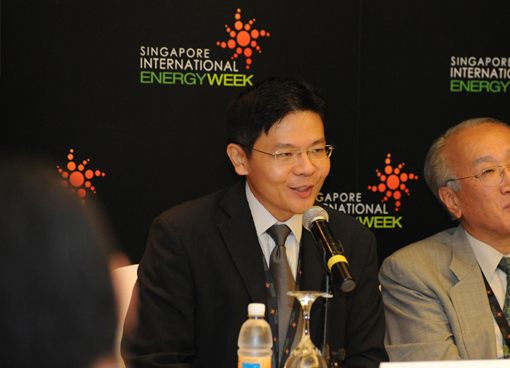This is an extract of a Q&A that Singapore's Energy Market Authority's former Chief Executive Lawrence Wong held with Asian Trends Monitoring Bulletin, which asked a series of prominent leaders in their field to reflect on energy issues, possible emergent risks and their likely implications for the region.

What are the key policy initiatives needed in the region to ensure continued energy security over the next decade Lawrence Wong: The security of energy supplies is an important concern for all ASEAN countries. One strategy to achieve this is to diversify fuel sources. Several ASEAN countries are already tapping on renewable energy sources like geothermal and hydro. Some have also announced plans to build nuclear power plants in the longer term.
Singapore imports all its energy and have limited scope to deploy alternative energy on a large scale. 80 percent of its electricity today comes from gas-fired power plants using piped natural gas. Hence, the first priority in diversification is to diversify the sources of gas by importing liquefied natural gas (LNG). To enable this, Singapore is building an LNG terminal which will be ready by 2013.
Given the variation in energy resource endowments and demand requirements, each country in Southeast Asia will need to develop its own mix of measures to achieve energy diversification. As a region, it needs to continue to promote energy cooperation and work jointly on initiatives to build a more resilient energy market that enhances energy security for all ASEAN members.
In what ways do you envision ASEAN governments responding to climate change over the next decade LW:Climate change and energy issues are inextricably linked. On the energy side of the equation, ASEAN governments are pursuing several strategies. The first is to diversify to clean and renewable energy sources. There are, for example, several large-scale hydro projects being planned in Laos, Malaysia and Vietnam.
Second, governments are putting in place measures to promote energy efficiency. As a region, ASEAN is aiming for an 8 percent reduction in energy intensity by 2015 (compared with the 2005 level). ASEAN energy officials are now developing a systematic plan of action and monitoring mechanism to achieve this target and to see if more can be done beyond that.
Third, there will be greater investments in energy research and development (R&D). The new wave of energy technologies will cover the entire spectrum, from cleaner power generation to smarter distribution and usage of electricity. Across the region, countries are doing more in energy research. For example, Singapore have invested considerable sums in energy R&D and are also providing platforms for piloting and test-bedding of new energy technologies.
The year is 2020: has nuclear energy in ASEAN made the big gains everyone in 2010 had anticipated LW: Harnessing nuclear energy is a complex and long-term enterprise for any country. Rather than focusing on achieving 'big gains' within a certain timeline, it is more important to systematically build up the capability base and to have the proper systems, safeguards and standards. ASEAN is looking at efforts to build regional capacity in civilian nuclear energy. Last year, the ASEAN Energy Ministers endorsed the Terms of Reference for the Nuclear Energy Cooperation Sub-Sector Network, which will form the body to coordinate such activities in the region.
What will be the biggest changes in ASEAN's energy sector (electricity markets, liquid fuels, renewables, etc.) over the next 5–10 years LW: Energy is a long-term business. So the changes in the sector over the next 5–10 years are likely to be a continuation of present trends. One key driver is the continued increase in energy demand. The International Energy Agency has projected energy demand in ASEAN to grow at an annual rate of 2.5 percent, much faster than the world average of 1.5 percent. While the region may be using energy more efficiently, the growing appetite for more power as a result of rapid economic growth will far outpace any efficiency gains. New power plants will have to be built to meet this demand.
Not with standing the growing interest in renewable energy, the reality is that green power currently is still more expensive than fossil fuels by a significant margin and lacks the scale to replace more than a small proportion of fossil fuel use. Hence, most of the new plants over the next five–10 years will be powered by fossil fuels. Within the fossil fuel mix, however, it is likely to see an increase in gas-fired plants. From a sustainability perspective, this is a positive trend because gas is the cleanest of fossil fuels--compared to other hydrocarbons like oil and coal, natural gas produces lower levels of carbon emissions and air pollution. To ensure access to gas supplies, several ASEAN countries are also developing facilities to import LNG. This can help to facilitate LNG trading among the regional countries.
By 2020, what do you think will be the status of regional cooperation projects like the ASEAN Power Grid and the Trans-ASEAN Gas Pipeline LW: To improve the resilience of the region's electricity and gas systems, it makes sense for ASEAN to pursue an integrated power grid and a connected gas pipeline. However, these are very complex undertakings. Realistically, it will take a long time to achieve the vision of a fully inter-connected regional energy market, especially given the diverse natures of the electricity and gas industries across the region. But there are already efforts to connect more countries bilaterally, whether through transmission cables or gas pipelines. As these efforts take shape, a gradual and steady move towards closer regional connectivity will evolve as well.
Article extracted from Asian Trends Monitoring Bulletin, which focuses on three areas of strategic concern to Asia's well being and future development, namely trade and investment facilitation; health systems, and energy security. For the full report, click here.
By : Asian Trends Monitoring Bulletin